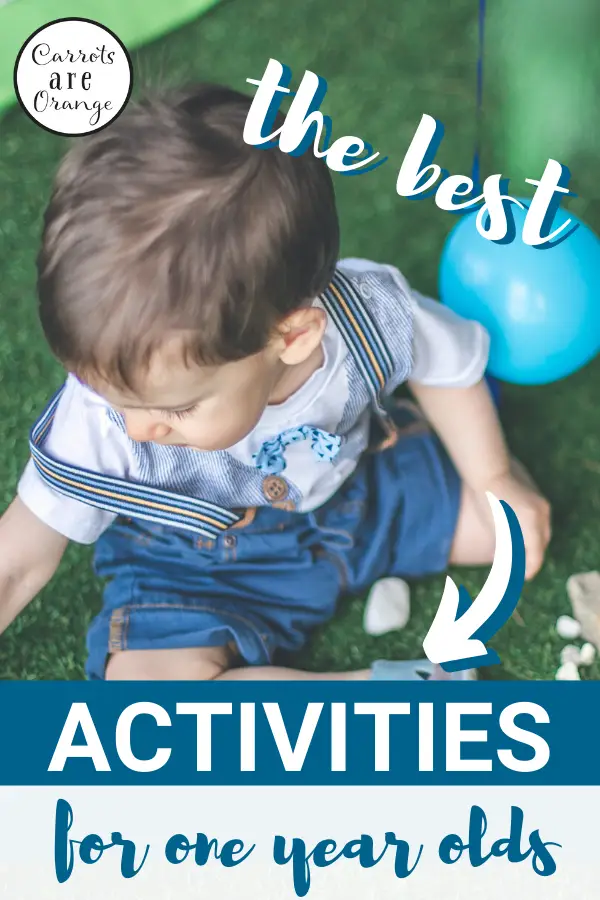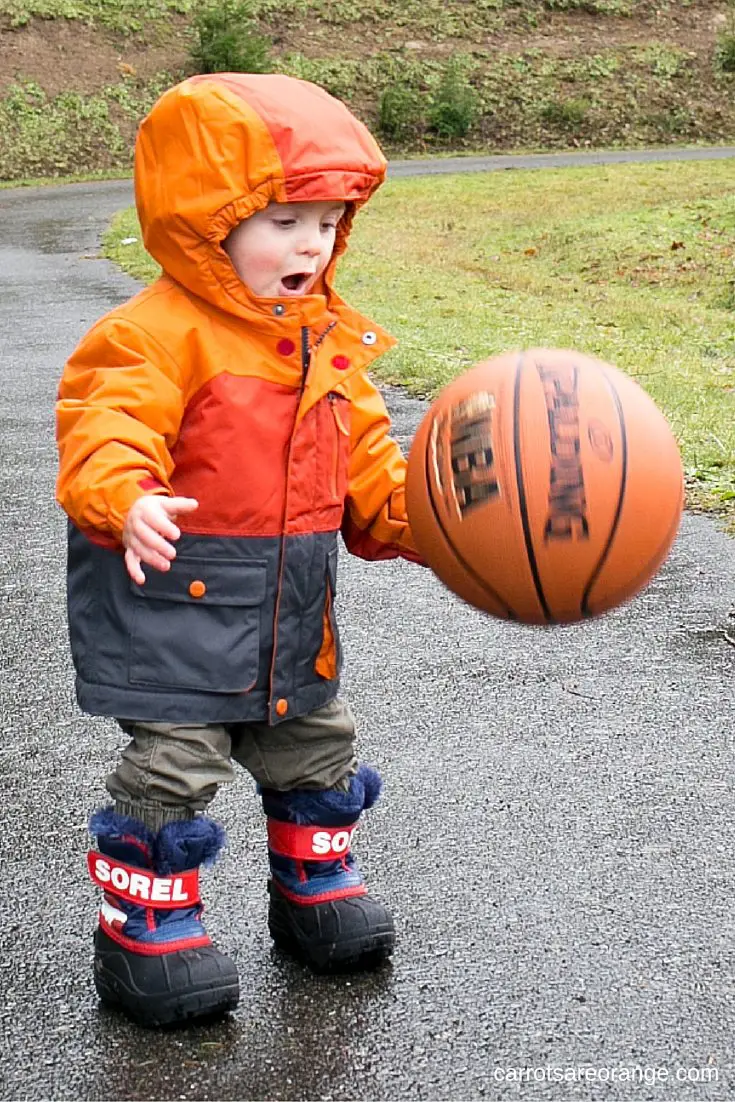Do you know one-year-olds that want to do everything by themself?
Do these young children also love to mimic whatever you're doing?
Montessori is ideal for this child! There are a lot of options for Montessori toys for a 1-year-old. Like many parents, you might assume that Montessori activities are too involved for one-year-old children. Yet, nothing could be further from the truth! There are loads of Montessori activities for one-year-olds.

Montessori Activities for 12-Month-Olds
Montessori revolves around three things: hands-on learning, self-directed learning, and developing key life skills such as independence, self-esteem, and concentration.
While the typical one-year-old isn't ready to play collaboratively, there are lots of hands-on learning and self-directed activities that they are developmentally ready to tackle. In other words, a one-year-old is beyond baby play!
This fact is great news for a stay-at-home mom and dad. Plus, baby activities don't have to be…well, babyish! To give you an idea, we've compiled a brief list of examples that are suitable for kids between the ages of 12 and 24 months.

One-Year-Old Milestones
According to the CDC, observing your child's movements, speech, play, and learning is critical to understanding his development. If you're concerned or curious about a child's development, the CDC offers a free milestone tracker app and printable checklist.
Briefly, however, the CDC offers this list of developmentally appropriate milestones for a one-year-old child:
Social and Emotional
- Is shy or nervous with strangers
- Cries when mom or dad leaves
- Has favorite things and people
- Shows fear in some situations
- Hands you a book when he wants to hear a story
- Repeats sounds or actions to get attention
- Puts out arm or leg to help with dressing
- Demonstrating attachment to familiar caregivers
- Playing & enjoying social interactions, such as playing peek-a-boo or pat-a-cake
- Showing signs of empathy, such as comforting others who are upset
- Exhibiting a range of emotions, including joy, frustration, and fear
- Exhibiting some independence and asserting preferences
Language/Communication
- Understands and responds to simple spoken requests or commands
- Uses simple gestures, like shaking head “no” or waving “bye-bye”
- Makes sounds with changes in tone (sounds more like speech)
- Says “mama” and “dada” and exclamations like “uh-oh!”
- Tries to say words you say
- Babbling with a variety of sounds and intonations
- Responding to simple words or phrases, such as their own name
- Using gestures or pointing to communicate needs or desires
- Attempting to imitate or repeat words or sounds
Cognitive (learning, thinking, problem-solving)
- Explores things in different ways, like shaking, banging, throwing
- Finds hidden things easily
- Looks at the right picture or thing when it’s named
- Copies gestures
- Starts to use things correctly; for example, drinks from a cup, brushes hair
- The child bangs two things together
- Puts things in a container, takes things out of a container
- Lets things go without help
- Pokes with index (pointer) finger
- Follows simple directions like “pick up the toy”
- Recognizing familiar objects and people
- Understanding simple commands or gestures
- Engaging in simple pretend play, such as pretending to talk on a toy phone
- Exploring cause-and-effect relationships, such as dropping objects to see them fall
- Showing interest in picture books and turning pages
Physical Development
- Gets to a sitting position without help
- Pulls up to stand, walks holding on to furniture (“cruising”)
- May take a few steps without holding on
- May stand alone
- Crawling, cruising, or walking with support
- Attempting to climb stairs or furniture
- Picking up small objects using the pincer grasp (thumb and forefinger)
- Feeding themselves with fingers or a spoon
- Exploring objects by shaking, banging, and throwing
Gross and Fine Motor Skills
- Sitting without support
- Rolling over both ways
- Crawling or creeping on hands and knees
- Using hands to manipulate objects, such as stacking blocks or fitting shapes into holes
- Attempting to scribble or make marks with crayons or markers
It's important to note that every child develops at their own pace, and these milestones are meant to provide a general guideline. If you have concerns about your child's development, it's recommended to consult with a pediatrician or early childhood professional.

15 Easy Montessori Activities for a One-Year-Old
#1 – Banana Peeling
This tasty activity is easy for parents to prepare and lends right to food preparation & practical life skills. It doubles as a snacking opportunity too, so you can take care of two birds with one stone.
Cut an unpeeled banana into thick slices. They will resemble thick disks. Carefully slice along one side of each to make a “starting place” for your little one to grab onto, and then demonstrate to them how to lift and pull the peel off of the banana slice.
Most one-year-olds are able to handle this well, and they love the payoff: a delicious slice of banana! I love this banana slicer from Montessori Services!
#2 – Threading with Large Beads, a Strainer, or a Can
A large bead stringing activity is great for developing hand-to-eye coordination in toddlers. Clean out an old coffee can or any container with a thin, plastic lid that snaps on securely.
Poke small holes around the lid, and get some thin, colorful sticks to push through the holes. Make sure that the sticks are long so that they can't be swallowed by your tot.
Instruct your child to put all of the sticks in the container by pushing them through the holes. If they appear to struggle, consider making the holes a little bigger.

More Activities for 12-Month-Olds
#3 – Pointing and Naming
Because it can be done just about anywhere, this activity is very useful in a number of situations. As you've probably surmised, it simply involves pointing to objects and asking your child to name them.
You can do this with actual children's picture books, or you can simply point out objects when you're out and about with your kid. As your child gets older, you can also create a photo album with photos of friends and loved ones and have them name each one as you point to them.
#4 – Loading & Unload Clothes
Get a little help on laundry day by including your toddler. Place the dirty clothes hamper by the washing machine, and show your little one how to place clothes inside. Most kids get a kick out of it, and you get a little assistance too!
Food preparation is a fantastic activity for even the youngest child!
#5 – Peeling Stickers
Stock up on poster boards, pieces of paper, cardboard boxes, and packs of stickers. Let your toddler decorate the poster board with dots as they see fit. Demonstrate how to peel stickers and intervene when you need to. Stickers are an excellent way to help develop fine motor skills.

#6 – Sensory Bins
Create a sensory bin filled with materials like rice, beans, or water for your one-year-old to explore with their hands and senses.
#7 – Object Permanence Box
Introduce an object permanence box where your child can drop objects through a hole and discover that they still exist even when out of sight.
#8 – Shape Sorting
Provide your one-year-old with various shapes and a corresponding shape sorter to practice hand-eye coordination and shape recognition.
#9 – Water Play
Set up a shallow basin with water and child-safe toys for your little one to splash, pour, and explore the properties of water.
#10 – Treasure Baskets
Assemble themed treasure baskets with safe objects from around the house to stimulate your child's curiosity and sensory exploration.

#11 – Simple Puzzles
Introduce basic puzzles with large, easy-to-grasp pieces to develop problem-solving skills and fine motor control.
#12 – Montessori-inspired Art
Encourage artistic expression by providing non-toxic art supplies like large crayons and finger paints for your one-year-old to create their own masterpieces.
#13 – Practical Life Activities
Involve your child in simple household tasks such as wiping a table, transferring objects with tongs, or sorting objects into containers to foster independence and coordination.
#14 – Nature Walks
Take your one-year-old on nature walks to explore the outdoors, observe different plants and animals, and engage their senses with the sights, sounds, and textures of nature.
#15 – Gross Motor Play
Create a safe space for your child to crawl, climb, and explore their physical abilities through activities like crawling through tunnels, playing with balls, or using soft play equipment.
Infant & Toddler Montessori Resources
- Montessori Services has loads of infant & toddler Montessori items
- AMS Suggested Infant & Toddler Materials
- Amazon has endless ideas for Montessori toddler & infant activities
- Montessori in the Home for Infants and Toddlers
- Montessori Toys for Babies & Toddlers: 7+ Ideas for You
- The Ultimate Infant & Toddler Montessori Toys Guide
- My Top Infant and Toddler Montessori Materials
- Montessori Infant & Toddler Activities
As you can see, there are all kinds of ways to introduce your one-year-old to Montessori activities. By starting your child on them early in life, they will get that much more out of their Montessori learning experiences.
The greatest part about the Montessori lifestyle is how many activity variations and extensions exist! Use your imagination and follow your child's lead. A little observation can go a long way.
Check out this post if you are looking for activities for toddlers!
Best,
Marnie
